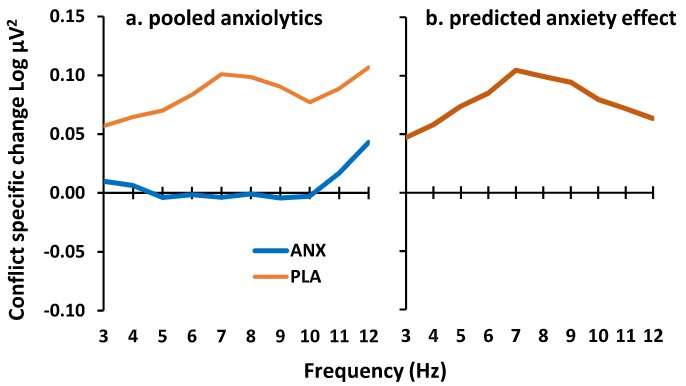Figure 1. Predicted GCSR difference in high anxiety cases. (a) Average GCSR over three classes of anxiolytic drug (ANX, N = 26) compared with placebo (PLA, N = 8). Data are from the same participants as we reported previously39, but with different analysis parameters matching those of the current paper and with 3-point smoothing of Fig. 4. (b) The difference curve between these two groups as an estimate of expected anxiety-related power change predicted for high trait anxiety and for clinically diagnosed anxiety relative to their respective controls (c.f. Fig. 4). Credit: DOI: 10.1038/s41598-021-99374-x
A University of Otago researcher has discovered a brain signal that will help improve the diagnosis and treatment of anxiety disorders.
Professor Neil McNaughton and his team from the Department of Psychology have completed the final step in testing their biomarker, a brain rhythm produced by emotional conflict, in patients with anxiety.
The research, funded by the NZ Health Research Council and now published by Nature in Scientific Reports, found that patients with anxiety disorders had high conflict rhythmicity that differed in its extent across diagnoses.
Those with high scores represent a specific kind of anxiety disorder, which will be more likely to respond to specific anti-anxiety drugs. However, those with particularly extreme scores will be resistant to conventional treatment.
Professor McNaughton says the biomarker is based on a theory that has been evolving for more than 50 years.
It is an important break-through as current psychiatric diagnoses use symptoms (e.g. cough) not causes (e.g. SARS-CoV-2), so there are no clear targets for therapy, and current treatments, both drugs and psychological, have low response rates.
The new biomarker can help develop new diagnostic tests and treatments for anxiety disorders, meaning patients will achieve remission faster and with a less hit-and-miss choice of treatments, he says.
"Our biomarker provides an immediate foundation for the development of new drugs and for diagnostic tests that could guide treatment choice and so improve response rates."
In the longer term, the underlying theory of the research should also allow similar advances across the range of threat and stress-related disorders.
"This could represent a revolution in the application of theoretical neuroscience to psychiatry, and to the current trend to link psychopathology with personality theory."
Better treatment for anxiety disorders will help reduce the burden on patients, their families, workplaces, and governments through reduced health costs, Professor McNaughton says.
More information: Shabah M. Shadli et al, Right frontal anxiolytic-sensitive EEG 'theta' rhythm in the stop-signal task is a theory-based anxiety disorder biomarker, Scientific Reports (2021). DOI: 10.1038/s41598-021-99374-x
Journal information: Scientific Reports
Provided by University of Otago






















